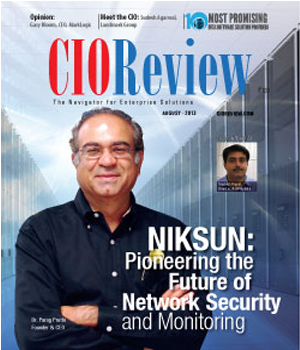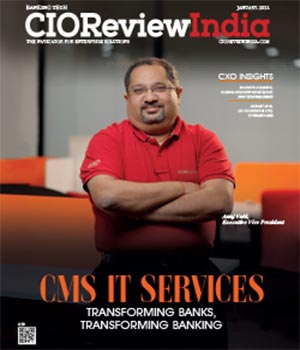
Bridging the Gap: No-Code Platforms and Business-IT Collaboration
Mr. Muzammil Patel, Global Head Strategy and Corporate Finance at Acies | Tuesday, 12 September 2023, 13:13 IST
 In an interaction with Bimlesh Prasad, Correspondent at CIOTechoutlook magazine, Mr. Muzammil Patel, Global Head of Strategy and Corporate Finance at Acies has discussed the advantages of No-Code technology across different areas of business operations and how this platform is poised to transform the landscape of software development life cycle (SDLC) methodologies like agile and DevOps. Below are the excerpts from the exclusive interview -
In an interaction with Bimlesh Prasad, Correspondent at CIOTechoutlook magazine, Mr. Muzammil Patel, Global Head of Strategy and Corporate Finance at Acies has discussed the advantages of No-Code technology across different areas of business operations and how this platform is poised to transform the landscape of software development life cycle (SDLC) methodologies like agile and DevOps. Below are the excerpts from the exclusive interview -
Muzammil has more than two decades of experience in collaborating with top financial institutions and corporate clients. He specializes in advisory and technology solutions, driving transformative programs to tackle regulatory and business issues. He advises regulators and industry bodies, contributing to supervisory frameworks in risk management areas. He is a Chartered Accountant and a Financial Risk Manager.
How do no-code platforms help the BFSI industry?
In today's banking, financial services, and insurance industry, no-code platforms play a crucial role. They offer several key benefits that extend beyond the realm of a specific business unit.
Firstly, no-code platforms enable rapid application development, drastically reducing the time required to create new applications from months to just a couple of weeks, depending on complexity. This accelerated pace enhances agility. Secondly, no-code platforms significantly reduce costs. Both initial development and ongoing maintenance expenses decrease to about one-fifth of what traditional app development would incur. This cost-efficiency promotes sustainability and profitability. Thirdly, no-code platforms empower users to shape applications according to their needs right from day one. This user-centric approach results in applications that better align with use cases, eliminating the need for compromises that often arise in traditional development processes.
These advantages are the foundation of no-code platform adoption across various industries over the past few years, demonstrating their value in today's fast-paced digital landscape.
What are some of the key advantages that organizations have experienced when adopting no-code platforms for their business operations?
Organizations are currently reaping numerous benefits from no-code platforms across three key areas: employee engagement, internal operations optimization, and customer engagement. Firstly, in employee management and automation of internal operations, no-code tools have led to substantial reduction in technology delivery costs. This cost reduction extends beyond application development to encompass ongoing maintenance and change requests, resulting in significant savings.
Moreover, digital transformation has accelerated as many previously deemed out-of-scope projects are now feasible due to the efficiency of no-code platforms. Regarding customer engagement, no-code solutions have enhanced customer interaction through improved content and engagement models. They have facilitated the transition to more efficient self-service and service request management, ultimately enhancing customer service quality.
While no-code has made remarkable strides in these areas, significant opportunities remain untapped. There is potential for no-code to expand into end-to-end customer engagement platforms and replace legacy technologies, simplifying the overall customer journey and service processes. In summary, no-code technology has proven highly advantageous in various organizational aspects, but its potential for further enhancement is vast.
What does the future of no-code platforms look like? Do you anticipate any major advancements or trends in this space?
The future of no-code platforms holds exciting prospects in the coming years, marked by significant advancements. Currently, no-code platforms are in their early stages, poised for substantial growth. Traditionally, these platforms relied on visual drag-and-drop interfaces, a significant improvement over coding. However, the future envisions a remarkable transformation. We're moving towards a scenario where users can engage with these platforms in a conversational manner. This shift will incorporate generative AI and machine learning, enabling natural language interactions and intelligent suggestions.
Conversations with no-code platforms won't be one-sided; they'll become more dynamic and adaptive. These platforms will learn from users' preferences and offer recommendations based on collective user experiences. Ultimately, this evolution aims to democratize app development. In the next four to five years, virtually anyone can harness no-code platforms to turn their ideas into functional applications. This progressive shift toward conversational, intelligent no-code platforms is the future trajectory, promising a more accessible and user-friendly landscape for application development.
What role do no-code platforms play in the larger landscape of software development approaches such as agile or DevOps?
The emergence of the second-generation no-code platforms is poised to transform the landscape of software development applications significantly. In the realm of DevOps, a notable shift is already underway, heralding a departure from the conventional Software Development Life Cycle (SDLC). The traditional SDLC, although robust, often consumes substantial time. The pivot towards expansive agile frameworks and the adoption of no-code solutions is propelling us toward a Continuous Integration and Continuous Development (CI/CD) paradigm. This transition entails two noteworthy outcomes.
Firstly, Agile sprints, which have been a staple, are now undergoing compression, potentially shrinking to mere minutes or smaller components. Secondly, the development process is becoming increasingly responsive to real-time feedback. Analytics is becoming integral, monitoring user behavior, engagement levels, and proffering suggestions for UI enhancements or modifications to the end-user journey.
In essence, the conventional SDLC is fading into obsolescence while Agile methodologies become progressively more condensed. The imminent future is one driven by a CI/CD approach intertwined with instantaneous integration of analytical insights. This transformation reflects a profound cultural shift in software development, reflecting the escalating expectations of users, who now anticipate rapid development turnarounds, from concept to delivery. This cultural transformation promises to redefine the software development landscape.
How are no-code platforms integrated into an organization's current systems or technologies?
Integrating platforms into existing systems and technologies resembles a chicken and egg dilemma. Historically, the prevalent approach involved leaving core systems untouched and constructing digital or transformational layers using additional platforms, typically around or on top of these core systems. The rationale was to avoid disrupting existing operations, reserving no-code platforms for newer endeavors. However, this paradigm is evolving as legacy technologies reach the end of their life cycles. Even core systems are transitioning to no-code platforms. This transition phase offers intriguing dynamics: some seek to extend the life of legacy systems, while others are embracing core platforms for their core systems. Yet, the prevailing trend remains the use of no-code platforms as digital layers alongside existing core technologies. These platforms communicate with existing technologies through well-established APIs, forming a crucial part of the overall architecture. This shift illustrates the dynamic nature of technology integration within contemporary systems and underscores the importance of adaptability in the ever-evolving tech landscape.
How do you foresee the future of the industry evolving with the increasing adoption of no-code platforms, and what kind of business outcomes can companies expect in the long term?
As we delve into the future of the no-code platforms and their impact on various industries, it's essential to consider the broader evolution of these industries. We are moving towards an era characterized by software on demand, extending beyond the conventional software-as-a-service model. Organizations will have the capability to create and tailor software solutions to their specific needs extensively.
Historically, businesses have often conformed to specific industry norms, adopting similar technologies and business models. This has led to a degree of uniformity and limited innovation. However, as we progress, we can expect a departure from these rigid industry boundaries. Businesses will craft their unique software ecosystems, resulting in diverse and evolving business models, even within the same industry or sub-industry.
This shift promises a plethora of opportunities for growth and innovation that were previously untapped. Additionally, the emergence of a creator economy is on the horizon. Users generating assets like UI elements and visuals while interacting with software will find avenues to monetize their creations through no-code marketplaces, fostering rapid development.
In summary, the future holds the promise of highly customized software solutions, a departure from industry conformity, and the rise of a dynamic creator economy, all contributing to lasting impressions and transformative business models.
CIO Viewpoint
Indian INCs Look at Investment in Security Big...
By Ron Davidson, CTO and Vice President, R&D, Skybox Security
IT Strategy Needs Frequent Updates
By Sankaranarayanan Raghavan, Director-IT, AEGON Religare Life Insurance
Innovation & Governance through Business Alliances
By Larissa Tosch, CIO, Glatfelter Insurance Group
CXO Insights
Revolutionizing BFSI: The Impact of AI and ML...
By Mike Yesudas, CTO, SunTec Business Solutions
Bridging the Gap: No-Code Platforms and...
By Mr. Muzammil Patel, Global Head Strategy and Corporate Finance at Acies
The Impact of Custom Software on the Indian...



.jpg)



